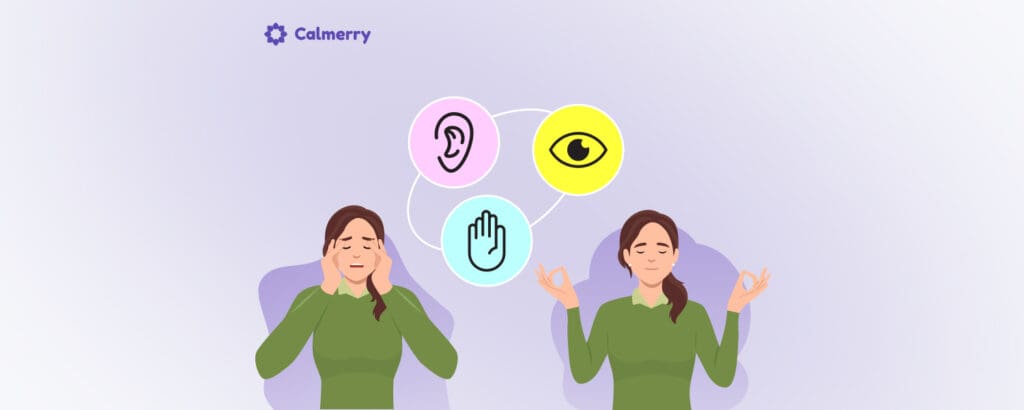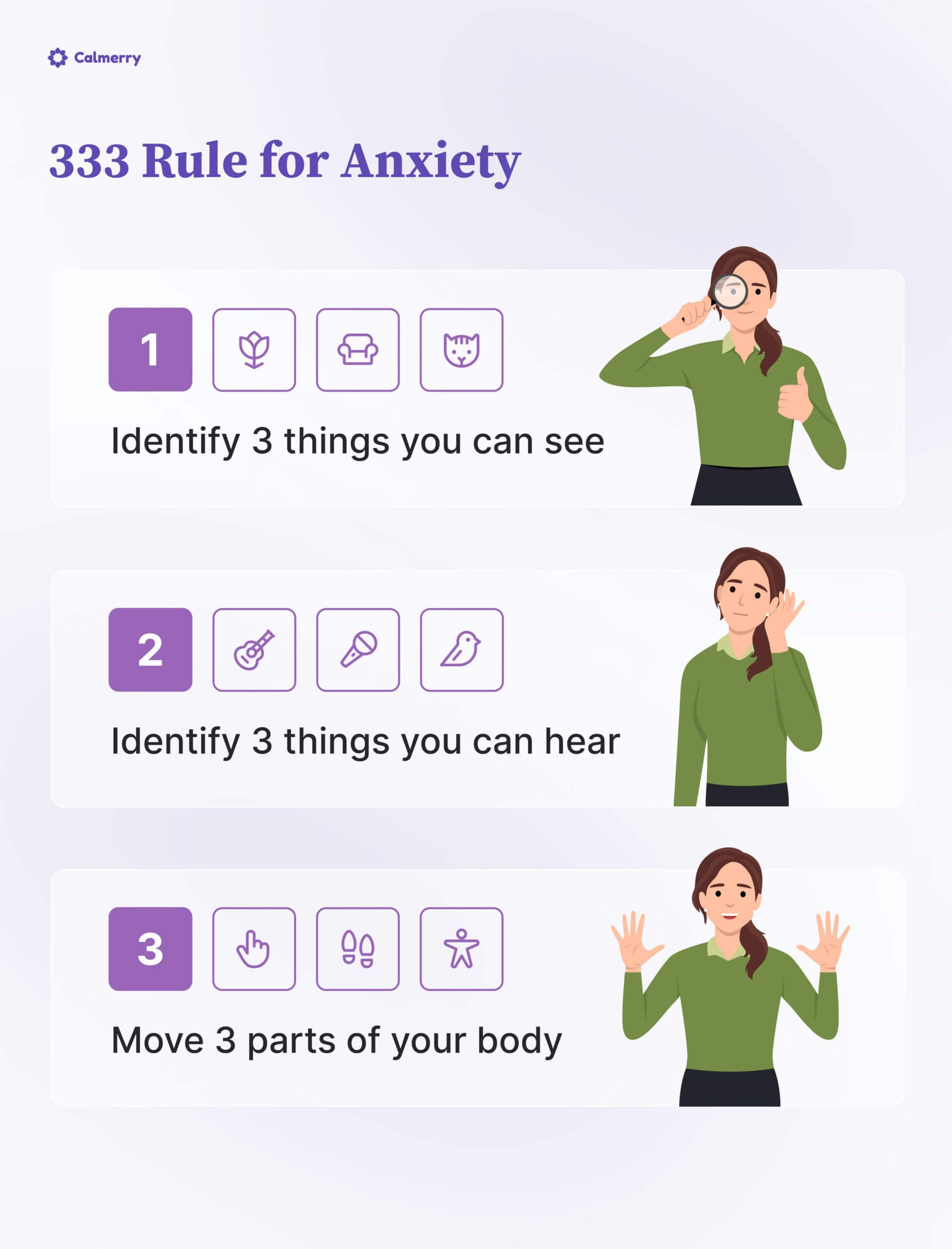The 333 Rule for Anxiety: Steps, Benefits, and When to Use It

In this article
Do you ever feel like anxiety is running the show?
Maybe you experience frequent panic attacks or just a general feeling of on-edge stress throughout the day. If so, you’re not alone.
Anxiety is incredibly common, affecting millions of people around the world. According to the World Health Organization, anxiety disorders currently affect an estimated 4% of the global population. [1] World Health Organization: WHO. (2023, September 27). Anxiety disorders. https://www.who.int/news-room/fact-sheets/detail/anxiety-disorders
The good news is there are ways to manage anxiety and take back control. You don’t have to white-knuckle your way through every anxious moment.
While there might not be a one-size-fits-all solution, many people find the 333 Rule a practical and effective tool for calming themselves down in the moment.
What is the 333 Rule for Anxiety?
The 333 Rule for anxiety is a simple yet powerful technique designed to help ground you in the present moment when anxiety strikes.
It’s a mindfulness technique to gently nudge your focus away from anxious thoughts and bring you back to the present moment. [2] Singh, S. K., & Gorey, K. M. (2017). Relative effectiveness of mindfulness and cognitive behavioral interventions for anxiety disorders: Meta-analytic review. Social Work in Mental Health, 16(2), 238–251. https://doi.org/10.1080/15332985.2017.1373266
This method involves three easy steps that engage your senses and physical movements to distract your mind from anxious thoughts.

How does 333 work?
The idea behind the 333 Rule is to redirect your attention away from what’s causing your anxiety and towards your immediate environment.
By focusing on what you can see, hear, and physically feel, you break the cycle of worry and bring your mind back to the here and now. This can provide immediate relief and help you regain a sense of calm and control.
The 333 Rule is beneficial because it’s easy to remember and can be practiced anywhere – at home, at work, or in public. It’s a practical tool that anyone can use, regardless of age or background, making it accessible to everyone who struggles with anxiety.
How to practice the 333 Anxiety Rule
Practicing the 333 Rule for anxiety is straightforward and can be done in just a few moments. Here’s a step-by-step guide:
1. Identify 3 things you can see
Take a deep breath and look around your environment. Identify three different objects in your immediate environment. These could be anything from a picture on the wall to a cup on the table or a plant by the window.
Take a moment to focus on each item and really pay attention to the detail! Notice the colors, shapes, and textures of these objects.
Is there a vibrant flower blooming nearby? A unique piece of furniture?
Focus on these details to truly engage your sense of sight.
2. Identify 3 things you can hear
Next, close your eyes if you feel comfortable and shift your focus to your sense of hearing.
Identify three distinct sounds that you can hear, no matter how small. These might be the air conditioner’s hum, birds chirping outside, or the sound of your breathing.
Concentrate on each sound for a few seconds.
3. Move 3 parts of your body
Finally, involve your body by moving three different parts. This can be as simple as wiggling your fingers, shrugging your shoulders, or tapping your feet.
Pay attention to the sensation of each movement and how it feels in your body.
By following these steps, you shift your focus from the internal anxiety-provoking thoughts to the external world, which can help ground you and reduce your anxiety.
This simple exercise can be repeated as often as needed. It can be a lifesaver in moments of high stress or panic.
Benefits of using the 333 Rule
Feeling overwhelmed by anxiety can be like being stuck in a loop of negative thoughts and physical symptoms.
The 333 Rule offers several significant benefits as part of your relaxation techniques for managing anxiety.
Here’s how this simple method can help:
- Immediate relief: one of the 333 Rule’s biggest advantages is its ability to provide quick relief from anxiety. By shifting your focus to your surroundings and physical sensations, you can interrupt the cycle of anxious thoughts and feel calmer almost instantly.
- Enhances mindfulness: practicing the 333 Rule encourages mindfulness, the practice of being fully present in the moment. This can help reduce overall anxiety levels over time and improve your ability to handle stressful situations.
- Easy to remember and use: the 333 Rule is straightforward and easy to remember, making it a practical tool you can use anytime, anywhere. Whether you’re at work, at home, or in a public place, you can rely on this technique to help ground you and manage your anxiety.
- Non-intrusive: unlike some relaxation techniques that require specific environments or equipment, the 333 Rule can be practiced discreetly without drawing too much attention to yourself. This makes it ideal for use in social or professional settings where you might need a quick way to manage anxiety without anyone noticing.
- Reduced anxiety: by focusing on your senses and body, you interrupt the spiral of anxious thoughts and bring your attention back to the present moment. This can lead to a significant decrease in anxiety symptoms like a racing heart, shortness of breath, and dizziness.
- Improved focus: anxiety can make it difficult to concentrate on tasks or even hold a conversation. [3] Hallion, L. S., Steinman, S. A., & Kusmierski, S. N. (2018). Difficulty concentrating in generalized anxiety disorder: An evaluation of incremental utility and relationship to worry. Journal of Anxiety Disorders, 53, 39–45. https://doi.org/10.1016/j.janxdis.2017.10.007 The 333 Rule helps to clear your mind and refocus your attention, allowing you to think more clearly and navigate challenging situations.
- Promotes physical relaxation: the 333 Rule helps you release tension in your body by incorporating small physical movements. This physical relaxation can complement the mental calmness you achieve, making it a holistic approach to managing anxiety.
Including this 333 rule in your collection of relaxation techniques can provide a reliable and effective way to manage anxiety symptoms whenever they arise.
When to use this technique
The 333 Rule is a versatile tool used in various situations to help manage anxiety and stress.
Here are some specific instances when this technique can be put into action
During panic or anxiety attacks
When a full-blown anxiety or panic attack hits, it can feel like the world is spinning. The 333 Rule offers a quick and effective way to ground yourself and interrupt the cycle of escalating anxiety.
By focusing on what you can see, hear, and feel, you can break the cycle of panic and reduce the severity of the attack. This simple technique can be a lifesaver when you need immediate relief.
In stressful situations
We all face stressful daily situations, from work deadlines to social gatherings. If you know a particular situation typically triggers your anxiety, the 333 Rule can be beneficial.
Use it beforehand as a preventative measure to calm your nerves and approach the problem with a clearer head.
For example, try using the 333 rule during a conflict. Pausing this technique can help you manage your emotions and respond more thoughtfully.
It’s a practical way to handle stress without letting anxiety take over.
As a daily practice
The 333 Rule isn’t just for reactive situations. Practicing it regularly can enhance its effectiveness when anxiety strikes.
Incorporating the 333 Rule into your daily routine, even when feeling calm, strengthens the neural pathways associated with mindfulness and grounding.
This can make it easier to access this calming technique when you need it most. Set aside a few moments each day to use the 333 Rule, whether during your morning routine, a break at work, or before bed.
When to seek help from a therapist
While the 333 Rule is a powerful tool, it’s important to remember that it may not cure anxiety. If your anxiety is severe or interferes significantly with your daily life, it’s essential to seek professional help.
A therapist can teach you various coping mechanisms and develop a personalized treatment plan to address your needs.
Here are some signs that therapy for anxiety might be beneficial:
- Anxiety symptoms are persistent: if you experience anxiety most days of the week for several months, it’s a good idea to talk to a therapist.
- Anxiety disrupts daily life: is your anxiety making it difficult to go to work, school, or maintain healthy relationships? Therapy can equip you with tools to manage your anxiety and live a fulfilling life.
- Coping mechanisms aren’t working: if you’ve tried self-help strategies like the 333 Rule, but your anxiety persists, a therapist can provide additional support and guidance.
- You experience physical symptoms: if you experience severe physical symptoms of anxiety, such as frequent panic attacks, chest pain, or dizziness, these should not be ignored. These symptoms can be debilitating and might require professional intervention to address both the psychological and physical aspects of your anxiety.
- You experience other mental health conditions: anxiety often co-occurs with other mental health conditions like depression or OCD. A therapist can address all your concerns and create a comprehensive treatment plan.
- You have suicidal thoughts: if you are experiencing suicidal thoughts, please reach out for help immediately.
There is no shame in seeking help for anxiety. Therapy is a safe and effective way to manage your symptoms and improve your overall well-being.
If you’re ready, Calmerry can match you with a therapist for your needs within 1 hour.
World Health Organization: WHO. (2023, September 27). Anxiety disorders. https://www.who.int/news-room/fact-sheets/detail/anxiety-disorders
Singh, S. K., & Gorey, K. M. (2017). Relative effectiveness of mindfulness and cognitive behavioral interventions for anxiety disorders: Meta-analytic review. Social Work in Mental Health, 16(2), 238–251. https://doi.org/10.1080/15332985.2017.1373266
Hallion, L. S., Steinman, S. A., & Kusmierski, S. N. (2018). Difficulty concentrating in generalized anxiety disorder: An evaluation of incremental utility and relationship to worry. Journal of Anxiety Disorders, 53, 39–45. https://doi.org/10.1016/j.janxdis.2017.10.007
online therapy
live video session



